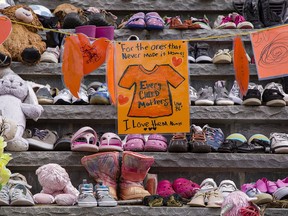
BRANTFORD Ottawa is providing $10,259,975 to help pay for the search for unmarked graves on the site of the former Mohawk Institute residential school in Brantford.
This advertisement has not loaded yet, but your article continues below.
The federal funding for the Survivors’ Secretariat at Six Nations of the Grand River will be provided over three years for the search, which began in November.
“We received $2.5 million as the first installment,” Kimberly Murray, executive lead for the Survivors’ Secretariat, said in an interview Wednesday.
“We’ve been spending it swiftly.”
Along with setting up a new corporation and non-profit agency, working with school survivors, seeking documents and interviewing for oral histories, the secretariat oversaw some of the test work on the use of ground-penetrating radar (GPR) and a pilot project using LIDAR, which uses laser and light to scan an area.
“In the fall, we had about 60 grids put down and geo-referenced on the land around the building and two GPR teams working on the grids,” said Murray.
“A 10-by-10 grid takes about an hour to cover. So, one acre takes about 40 hours, if the weather complies. I’d say we got about 25-30 grids complete before winter. We also did 10 acres with LIDAR scanning, which is done by drone.”
The LIDAR project cost about $50,000 for the 10 acres and, once a report has been received, the data from the two projects will be brought together to identify anomalies in the ground.
Meanwhile, the secretariat is also negotiating to get access to more than 14,000 documents, fighting with the province for both money and access to its archives.
The survivors also met over Zoom with the primate of the Anglican church and soon will be issuing a community call for members for a corporation, whose board will be made up entirely of survivors.
This advertisement has not loaded yet, but your article continues below.
“I think the survivors feel they didn’t have a voice when they were children in these schools and they want their voices to be heard first,” said Murray.
The secretariat’s website is drawing new survivors and Murray is preparing to release a newsletter and blog.
While she would like to see more federal funding – an initial budget of $24 million for three years was set, Murray said the federal government has been thoughtful in how it is providing funds.
“Canada has been very site specific asking, ‘What are your needs; what are you doing?’ but Ontario is using a cookie-cutter method, saying there were 18 schools in the province so we’re going to set aside $400,000 for each community.”
Murray said the needs of those communities will vary greatly since some schools were open for shorter times and were covered under 1935 legislation where all deaths had to be reported. The Mohawk Institute opened in 1828 and closed in 1970, making it one of the oldest and longest-running residential schools in Canada.
“No other institution has 600 acres of ground to investigate and some communities may not even want to do an investigation,” said Murray.
“I don’t want to compete with other communities that need to do this work but the approach shouldn’t be to give everyone the same funding.”
Ontario has since upped its offer of funding to $700,000 for each community over a period of three years.
Murray said an open investigation continues through the Ontario coroner’s office into the finding in 2020 near Glenwood Drive in Brantford of the remains of a young person. In 2021, the remains were determined to be a child or adolescent.
This advertisement has not loaded yet, but your article continues below.
“I believe the excavation is complete and the coroner has been speaking to the survivors to provide updates.”
And a new tip-line has been set up by the police task force for people to call if they have any information about a death in a residential school or any information about potential burial sites. That number is 1-888-523-8587.
In a news release, Six Nations elected Chief Mark Hill thanked Minister of Crown-Indigenous Relations Marc Miller for the funding, saying it is important in seeking justice for the survivors.
“This funding is an important step in the journey to bring out lost children home,” Hill said.
Survivor Sherlene Bomberry emphasized the work should continue to be survivor-led and centered.
“Our voices must be heard as we begin the work related to unmarked burials.”
About 15,000 students from 20 First Nation communities were at the Mohawk Institute. Records indicate there were 54 deaths at the school.
@EXPSGamble
